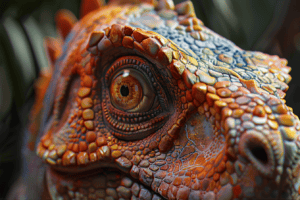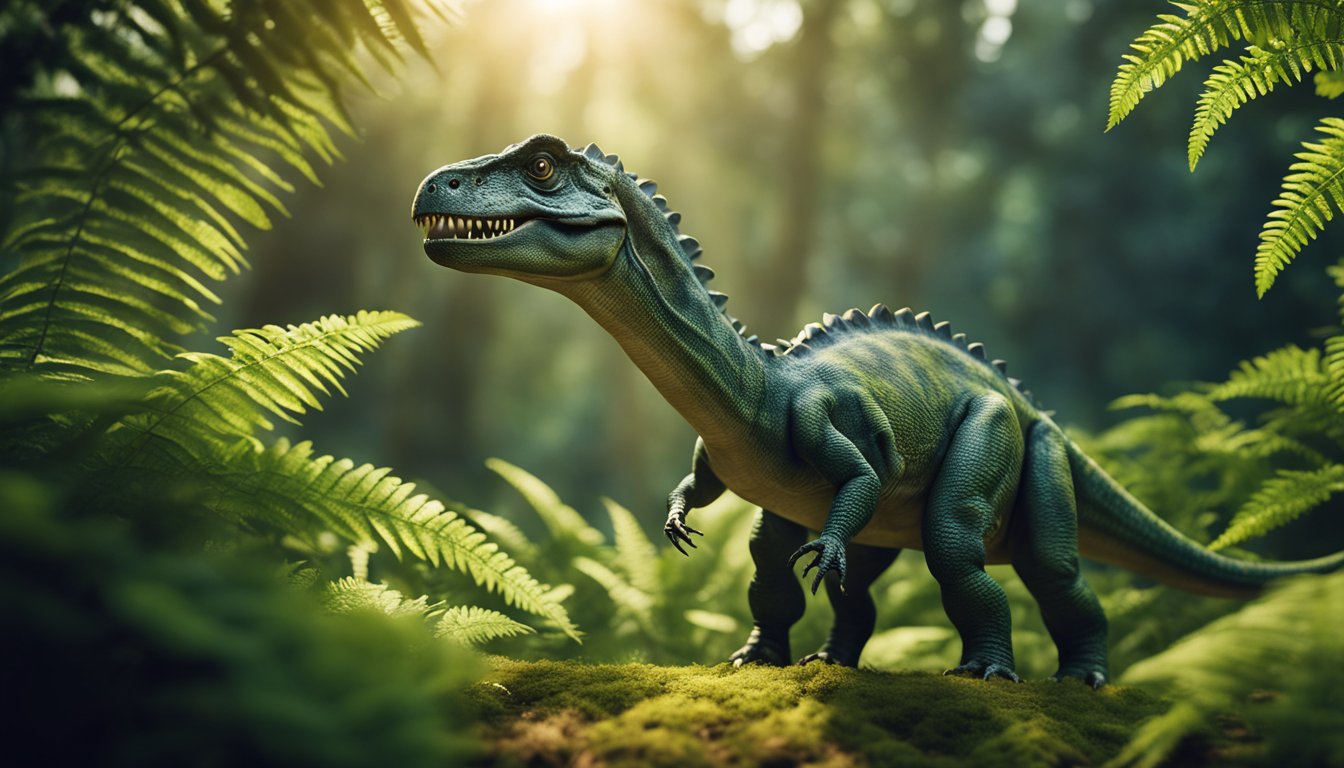Jobaria, the gentle giant of the Jurassic, was a massive dinosaur that roamed the earth over 164 million years ago.
This herbivorous sauropod is currently the only known valid dinosaur from the Tiouraren formation in Niger, where it was discovered in 1997.
Jobaria’s fossils were found in what is now the Sahara Desert, and they have provided scientists with valuable insights into the evolution and behavior of these fascinating creatures.

Measuring up to 18 meters in length, Jobaria was a towering presence in the prehistoric world.
Despite its massive size, this gentle giant was a peaceful herbivore that spent its days munching on plants and avoiding predators.
Its long neck and tail, along with its powerful legs, helped it to move around and reach for food in the treetops.
Jobaria’s bones were hollow, making it lighter and easier to move, but also more fragile.
Despite this, it was still a formidable creature that could defend itself if necessary.
Discovery and Naming
Jobaria tiguidensis, also known as “The Gentle Giant of the Jurassic,” is a species of sauropod dinosaur that lived in what is now Niger during the middle Jurassic Period, between 164 and 161 million years ago.
The discovery of Jobaria is a fascinating story that involves a local legend, a team of paleontologists, and a lot of hard work.
First Discoveries in Niger
The first bones of Jobaria were discovered in Niger in 1997 by a team of paleontologists led by Dr. Paul Sereno from the University of Chicago.
The fossils were found in the Tiouraren Formation, a geological formation that dates back to the middle Jurassic Period.
The team found the bones of several individuals, including a nearly complete skeleton that was over 60 feet long.
The Significance of the Name ‘Jobaria’
The name “Jobaria” comes from a local legend about a giant beast called “Jobar.” According to the legend, Jobar was a creature that lived in the mountains and was feared by the local Tuareg people.
When the paleontologists arrived in Niger to excavate the fossils, some of the Tuareg people believed that they had found the bones of Jobar.
The name “Jobaria” was chosen to honor the local legend.
Paul Sereno’s Contribution
Dr.
Paul Sereno, the leader of the team that discovered Jobaria, is a renowned paleontologist who has made many significant contributions to the field of dinosaur research.
He is known for his work on a variety of dinosaur species, including Spinosaurus, Suchomimus, and Afrovenator.
In the case of Jobaria, Sereno and his team spent several months excavating the fossils from the Tiouraren Formation and carefully piecing together the bones to create a nearly complete skeleton.
Overall, the discovery of Jobaria is an important milestone in the study of sauropod dinosaurs.
The fossils provide valuable insights into the anatomy, behavior, and evolution of these fascinating creatures.
Physical Characteristics

Size and Weight Estimates
Jobaria was a massive dinosaur, even by sauropod standards.
Based on the fossil evidence, scientists estimate that Jobaria was approximately 18 meters (60 feet) long and weighed around 20-25 tons [1].
That’s about the size of a school bus!
Its long neck allowed it to reach high into trees to eat foliage, while its powerful legs helped support its massive weight.
Unique Features of Jobaria
One of the most unique features of Jobaria was its tail.
Unlike other sauropods, which had long, whip-like tails, Jobaria’s tail was relatively short and stiff.
This may have been an adaptation to help the animal balance its massive body [2]. Another interesting feature of Jobaria was its vertebrae.
Unlike other sauropods, which had complex, multi-hinged vertebrae, Jobaria’s vertebrae were relatively simple in form.
This has led some scientists to suggest that Jobaria may be a primitive sauropod [3].
Comparisons with Other Sauropods
Jobaria was part of a group of dinosaurs known as sauropods, which also included Camarasaurus, Apatosaurus, and Brachiosaurus.
Compared to these other sauropods, Jobaria had a relatively short neck and a more compact body.
However, it still had many of the same features that made sauropods so successful, such as a large size and a long tail [1].
Overall, Jobaria was a fascinating dinosaur with many unique features that set it apart from other sauropods.
Its massive size and distinctive tail make it a memorable addition to the prehistoric world.
[1] Prehistoric Wildlife.“Jobaria.” http://www.prehistoric-wildlife.com/species/j/jobaria.html
[2] Kidadl.“Fun Jobaria Facts For Kids.” https://kidadl.com/facts/jobaria-facts
[3] Natural History Museum.“Jobaria.” https://www.nhm.ac.uk/discover/dino-directory/jobaria.html
Habitat and Behavior

Life in the Sahara Desert
Jobaria was a gentle giant that lived in what is now the Sahara Desert during the Middle Jurassic period, around 164 to 161 million years ago.
The Sahara was a very different place back then, with lush forests and rivers.
Jobaria was perfectly adapted to this environment, with a long neck and tail to help it reach high branches and a powerful body to defend itself against predators.
Diet and Social Behavior
As a herbivore, Jobaria’s diet consisted mainly of plants.
It is believed that they traveled in herds to find food and protect themselves from predators.
Jobaria’s social behavior is still not well understood, but it is believed that they may have had complex social structures similar to modern-day elephants.
Possible Predators and Defenses
Jobaria lived alongside many predators, including the fearsome Afrovenator. Despite its size, Jobaria had a few tricks up its sleeve to defend itself.
Its long tail could be used as a whip to fend off attackers, and its powerful legs could deliver a deadly kick.
However, when faced with a pack of predators, even Jobaria’s defenses may not have been enough to save it.
Fun Fact: Jobaria is one of the few dinosaurs that has been found in the Sahara Desert, which was once a lush and verdant landscape.
Scientific Significance

Evolutionary Insights
Jobaria is a genus of sauropod dinosaur that lived during the Middle Jurassic Period, between 164 and 161 million years ago.
It is currently the only known valid sauropod from the Tiouraren formation in Niger, where it was discovered in 1997.
The discovery of Jobaria fossils has provided paleontologists with a wealth of information about the origins and evolution of sauropod dinosaurs, which were some of the largest animals to ever walk the Earth.
Jobaria’s Place in the Dinosaur Family Tree
Jobaria belongs to the family tree of dinosaurs, specifically within the group of sauropod dinosaurs.
Sauropods are characterized by their long necks and tails, small heads, and massive bodies.
The discovery of Jobaria fossils has helped scientists better understand the evolutionary relationships between sauropods and other dinosaurs.
For example, Jobaria has been classified as a member of the Macronaria, a group of sauropods that includes some of the largest and most well-known dinosaurs, such as Brachiosaurus and Apatosaurus.
Contributions to Paleontology
The discovery of Jobaria fossils has contributed significantly to our understanding of the natural world.
For example, the fossils have provided valuable insights into the anatomy and behavior of sauropod dinosaurs.
Paleontologists have been able to study the bones and other remains of Jobaria to learn about its diet, movement, and other aspects of its biology.
Additionally, the discovery of Jobaria has helped to shed light on African mythology and the cultural significance of dinosaurs in that part of the world.
Overall, Jobaria is an important and fascinating dinosaur that has contributed significantly to our understanding of the natural world.
Its discovery has provided insights into the evolution of sauropod dinosaurs, as well as the biology and behavior of these massive animals.
The study of Jobaria fossils will likely continue to yield new discoveries and insights for many years to come.
Frequently Asked Questions

How tall was Jobaria during the Jurassic period?
Jobaria was a massive dinosaur that roamed the Earth during the Middle Jurassic period.
According to the Natural History Museum, Jobaria could grow up to 21 meters in length, which is about the length of two school buses!
It is believed that Jobaria was one of the largest animals to have ever walked the Earth.
What kind of diet sustained the massive Jobaria?
Jobaria was a herbivorous dinosaur, which means it only ate plants.
According to Prehistoric Wildlife, Jobaria had a long neck that helped it reach leaves from tall trees.
It is also believed that Jobaria had a unique way of processing food in its stomach, which allowed it to extract more nutrients from its food.
Can you describe the main physical characteristics of Jobaria?
Jobaria had a long neck and tail, as well as four sturdy legs.
Its legs were positioned directly beneath its body, which made it easier for Jobaria to support its massive weight.
It also had a small head and teeth that were adapted for chewing plants.
According to Wikiwand, Jobaria had a distinctive hump on its back that may have been used to store fat or regulate body temperature.
During which geological era did Jobaria roam the Earth?
Jobaria lived during the Middle Jurassic period, which lasted from about 174 million to 163 million years ago.
This was a time when the Earth was dominated by giant reptiles, including dinosaurs like Jobaria.
It is believed that Jobaria lived in what is now Niger, in Africa.
How much might a Jobaria have weighed?
Jobaria was one of the largest animals to have ever lived, and it is estimated that it could have weighed as much as 20 tons!
That’s about the same weight as two adult elephants.
According to Kidadl, it is believed that Jobaria’s massive size helped protect it from predators.
What distinguishes a Jobaria from other quadrupedal herbivorous dinosaurs?
One of the things that distinguishes Jobaria from other herbivorous dinosaurs is its unique physical features.
Jobaria had a distinctive hump on its back, as well as a long neck and tail.
It also had proportionately longer arms than other sauropods, which may have helped it to grab on to large prey like other dinosaurs.
Additionally, Jobaria had a unique way of processing food in its stomach, which allowed it to extract more nutrients from its food.







